Food Allergy & Anaphylaxis
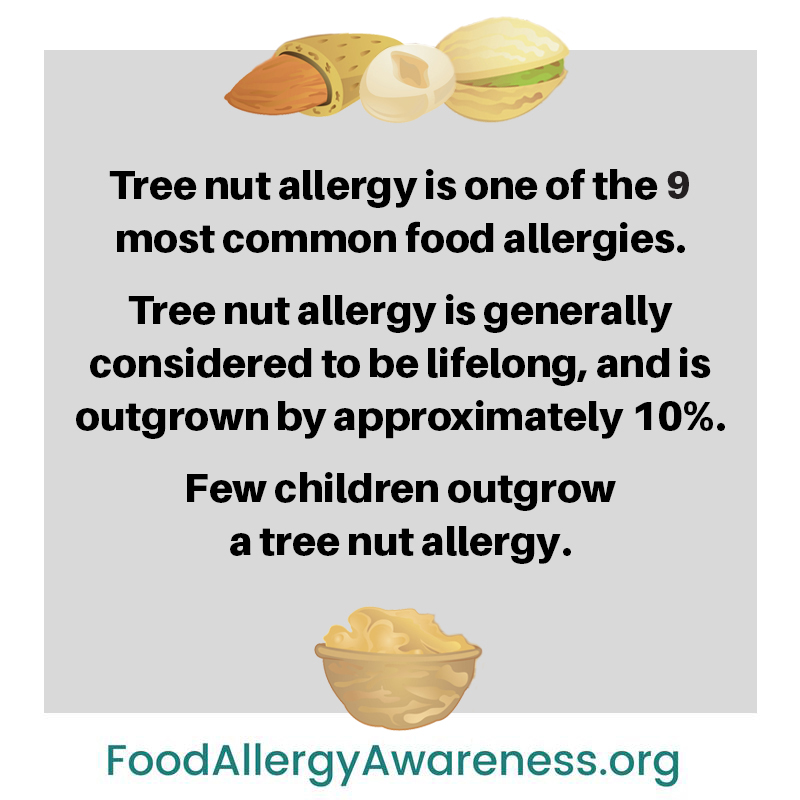
Tree Nuts
Tree nuts are one of the 9 most common food allergens. Tree nut allergy is generally considered to be lifelong and is outgrown by approximately 10%. Tree nut allergy often have a cross-reactivity with other different types of tree nuts. Additionally, there is some small risk of cross-reactivity with peanut, even though peanuts are actually a legume and not a tree nut. It is recommended that individuals see a board-certified allergist to discuss the need to avoid peanut due to a tree nut allergy, as well as the need to avoid all tree nuts. Because tree nuts have very similar structures, allergen tests may reveal multiple positive recognitions. However, all of these recognitions may not result in an allergic reaction. Oral food challenges may be useful to rule in or rule out if these nuts are safe to consume. In some cases where the tree nut allergic individual may tolerate selected tree nuts and not others, there is concern for possible cross-contamination due to co-processing of tree nuts by manufacturers. These are all issues that should be discussed with your board-certified allergist, since no universal rule is likely to apply to all tree nut allergic patients.
Tree nut prevalence rates in the United States are approximately 1% percent. Few children outgrow a tree nut allergy. Tree nut allergies account for the majority of IgE-mediated reactions in teenager and adult reactions. Delay in administering epinephrine for anaphylactic reactions to tree nut has been associated with deaths. [1]
Practical Tips
It is recommended to always carry at least two (2) epinephrine auto-injectors at all times if you have been diagnosed with a tree nut allergy. This is in case one misfires or if symptoms return and a second dose is needed. If an epinephrine auto-injector has been used, always seek emergency medical assistance immediately. This is due to the possibility of a biphasic reaction. A biphasic reaction is when a second wave of a reaction occurs, which is usually stronger than the first. It can occur within 2-4 hours and in some cases, up to 8 hours, after the initial reaction. Stay in medical care for at least 4-6 hours. Strict avoidance of tree nut and products containing tree nuts is necessary.
Read all product labels prior to the consumption of a new food product. Before consuming any products, it is important to always read labels carefully to ensure the safety of a food product. All food products that contain peanut protein as an ingredient are required by FALCPA law to list the word “Tree nut” on the product label.[1] The following ingredients may indicate the presence of peanut protein. Please note, manufacturing practices may change without notice. According to the Food Allergen Labeling and Consumer Protection Act (FALCPA), food products with the advisory statements such as “may contain”, “might contain”, or “manufactured in a shared facility that process” on a package are completely voluntary and can be ambiguous. The true level of contamination is not declared and may range from parts per million to micrograms. There may be different risks associated with these levels. It is generally recommended to avoid products with such labeling because of this uncertainty.
Cross-contact can occur when utensils between an unsafe food has been shared with a safe food. For example, shared cooking utensils or a deli meat slicer can be contaminated from nut-containing products. Cooking utensils should be thoroughly washed with soap and water. Another example of cross-contact can occur with picking out tree nuts from a meal and serving it to a tree nut allergic individual. This may be common with salads. It is still unsafe for consumption. A new clean plate, with a safe meal, should be served to the tree nut allergic individual.
Visiting restaurants can be a pleasant experience for family and friends to gather together. However, some restaurants may pose as a risk. Ethnic restaurants (such as Chinese, African, Indian, Thai and Vietnamese), ice cream parlors and bakeries are considered high risk for individuals with tree nut allergy due to the common use of nuts. Please review our restaurant page for tips on how to manage visiting a restaurant. Be vigilant, ask questions, and if there is any doubt, don’t eat the food item in question.
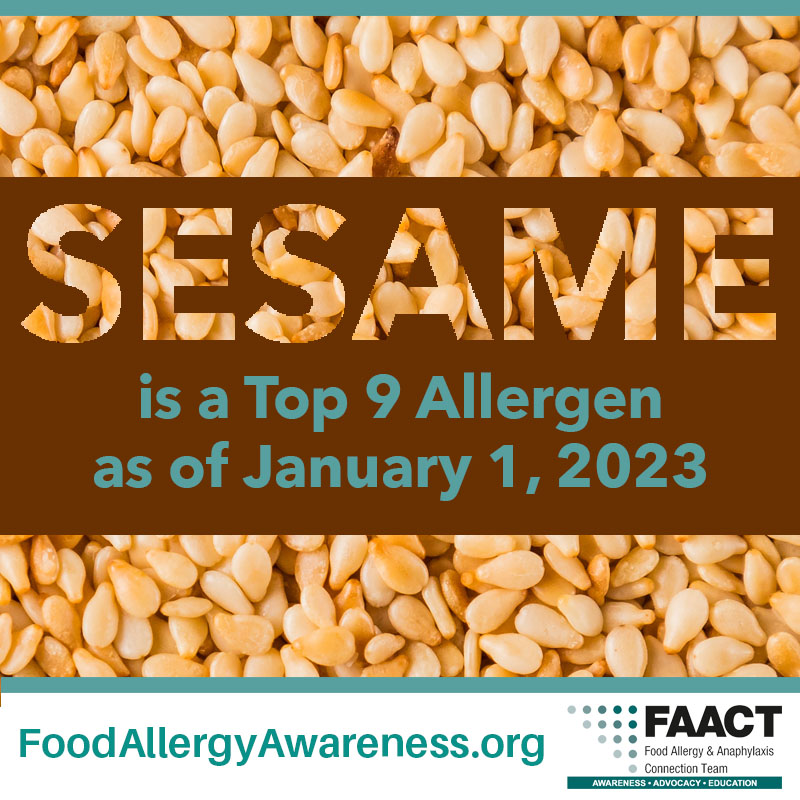
Sesame
Sesame is the ninth major allergen effective January 1, 2023 and must be labeled in plain language on packaged foods in the U.S. Foods containing sesame will be subject to specific food allergen regulatory requirements, including labeling and manufacturing requirements.
We remind consumers that foods already in interstate commerce before 2023, including those on retail shelves, do not need to be removed from the marketplace or relabeled to declare sesame as an allergen. So depending on shelf life, some food products may not have allergen labeling for sesame on the effective date.
- Previously safe products might have new sesame warnings; therefore, it is critical to read ALL labels as this transition takes place.
- Consumers should check with the manufacturer if they are not sure whether a food product contains sesame.
Under the FASTER Act of 2021, sesame is recognized as the 9th major food allergen effective January 1, 2023. Manufacturers must list it as an allergen, although in most cases it must appear in the ingredient statement.
From Mary H. Weiser Food Allergy Center:
In the latest Mary H. Weiser Food Allergy Center video webinar, moderator Kim Menzel, LMSW, a food-allergy informed social worker, is joined by Steven M. Gendel, PhD, who has more than 30 years of experience working to protect food safety and public health. Together, they discuss the FASTER Act provisions and other food labeling information for individuals and families coping with food allergy.
Dr. Gendel spent more than two decades developing science and policy in the FDA Center for Food Safety and Applied Nutrition. He was the first FDA Food Allergen Coordinator and contributed to the creation of agency policy, guidance documents, and regulations. He is an internationally recognized expert on food allergen management and on safety assessments for new food proteins. Currently, Dr. Gendel is an independent consultant at Gendel Food Safety LLC.
The FASTER Act and food labeling: What food allergy families need to know (YouTube)
Sesame allergy is a rising problem in the US and is now considered one of the top 9 allergens effective January 1, 2023. Approximately 0.23% of US children and adults are allergic to sesame(1). Other seeds that are known to cause allergy include pine nut, macadamia nut, flaxseed, sunflower seed, buckwheat, and mustard. Rates of sesame allergy may differ based on cultural dietary preferences. India, despite high intake of sesame, has low rates of allergy, though in other cultures such as Israel, sesame allergy is more common than peanut allergy.
Sesame consists of several major allergen classes, including seed storage proteins, vicillins, and oleosin. Testing for sesame allergy is potentially tricky. Oleosi, a major sesame allergen, is not detectable on skin testing, though the other major sesame allergens are. Therefore, both skin and serum testing for sesame allergy is highly recommended to avoid any false negative results. There may be differing amounts of allergens contained among the 3 varieties of sesame seeds. White sesame seeds contain the most allergen compared to brown or black seeds. However, all seeds are allergenic. Sesame oil is considered highly allergenic, as is sesame flour.
Individuals with a potential sesame allergy diagnosis should seek a board-certified allergist recommendation for confirmation. Testing should include both skin and blood testing because oleosins are poorly detectable by skin testing. Because sesame is a seed and has evolved from a plant, there are common proteins shared between other seeds, peanut, tree nut, and certain plants (in particular plants used for spices). Common proteins are even noted with carrot and kiwi. As is the case with peanut and tree nut, on allergy tests, the common proteins and similar structures may be responsible for high rates of co-positive tests when assessing for cross-reactivity. Please keep in mind that just having a positive allergy test does not automatically mean that the person is allergic to the item, especially if the person has never eaten the item and developed symptoms. Most of the cross-reactivity has little clinical significance, but always check with your allergist first. In some situations, a food challenge to the item in question may be recommended to determine if these items are safe to eat. However, in others, in particular the cross-reactive item was commonly eaten before the sesame allergy was diagnosed, a challenge is probably not necessary. However, some allergists do recommend total avoidance of potentially cross-reactive foods such as other seeds, peanut and/or tree nuts. The risk of sesame co-processing of these items is not well-described. Please check with your allergist for your specific management plan.
Common Sources of Sesame
|
|
|
|
|
|
|
|
|
|
|
|
|
|
|
|
|
|
|
|
|
|
|
|
|
|
|
Practical Tips
It is recommended to always carry at least two (2) epinephrine auto-injectors at all times if you have been diagnosed with a sesame allergy. This is in case one misfires or if symptoms return and a second dose is needed. If an epinephrine auto-injector has been used, always seek emergency medical assistance immediately. This is due to the possibility of a biphasic reaction. A biphasic reaction is when a second wave of a reaction occurs, which is usually stronger than the first. It can occur within 2-4 hours and in some cases, up to 8 hours, after the initial reaction. Stay in medical care for at least 4-6 hours. Strict avoidance of sesame and products containing sesame is necessary.
Read all product labels prior to the consumption of a new food product. Before consuming any products, it is important to always read labels carefully to ensure the safety of a food product. In the United States, sesame is required to be labeled per FALCPA. In some circumstances, if sesame is used as a flavoring agent and not a primary ingredient, sesame can be referred to as “spice” or “spices”.
Cross-contact from cooking utensils or products like using the same knife or spoon that was used for spreading hummus or eating lettuce from a salad bar right next to a dish of sesame seeds used as a condiment. Both pose a potential danger. The knife that was used is no longer safe for the sesame allergic individual. A new, clean knife should be used. As well, the salad bar represents a possible contaminated surface or cross-contaminated food. Lettuce and other salad items that are stored apart from the sesame should be used. Another example is scraping off sesame seeds from a meal and serving it to a sesame-allergic individual. It is still unsafe for consumption. A new clean plate, with a safe meal, should be served to the sesame-allergic individual.
Other pages that may be of interest:
Visit FAACT's “CROSS-CONTACT” page to review how to properly clean allergens from hands and surfaces.
Reference
(1) Prevalence and Severity of Sesame Allergy in the United States
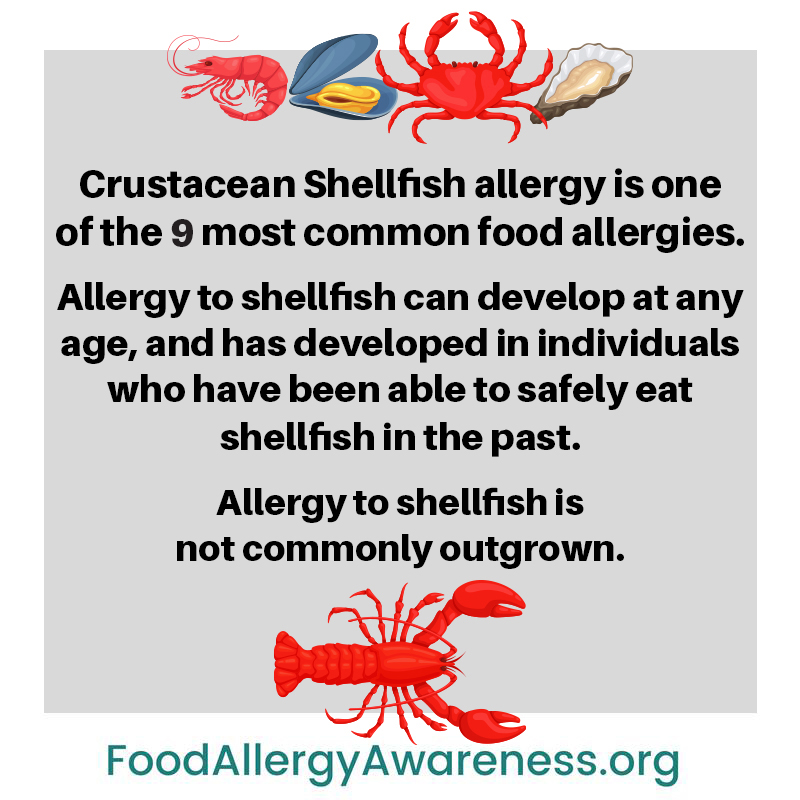
Crustacean Shellfish
Shellfish allergy is one of the most common food allergies affecting about 2% of the population according to a 2004 national telephone survey, including 2.5% of adults and 0.5% of children. More recent US estimates from 2011 noted 1.3% of children had reported shellfish allergy. Shellfish allergy is an IgE antibody-mediated reaction to proteins found in crustacean or mollusk family shellfish and is a common cause of anaphylaxis of foods. In one study reviewing causes of adult anaphylaxis, in 133 episodes of anaphylaxis 45 (34%) were stated to be due to shellfish allergy. Shellfish allergy may be most common in the Asia-Pacific region.
Allergy to shellfish can develop at any age, and has been reported to have developed in individuals who may have been able to safely eat shellfish in the past. Unfortunately, allergy to shellfish is usually life-long and not commonly outgrown. Strict avoidance of shellfish is recommended. NOTE: A shellfish allergy is different from a fish allergy. Those who are allergic to shellfish do not necessarily have to avoid fish, and vice versa.
There are two families of shellfish—molluscs (including hard shell bivalves clam, oyster, scallop, mussel; cephalopods squid, octopus; and gastropods abalone, snail, and whelk) and soft shell (arthropod crustacean species crab, lobster, prawn, shrimp, langoustine, crawfish). Crustacean allergy is more common, and only crustacean shellfish are required to be listed on labels in the US per FALCPA (not mollusk, and this is an important distinction to understand). The protein in crustacean shellfish is different than fin fish, and thus shellfish allergic individuals generally can eat fin fish. However, care should be taken to avoid cross-contamination.
Skin testing may be recommended in the evaluation of a shellfish allergy. These results must be interpreted cautiously due to the risk of cross-reactivity within the mollusk or crustacean family is common, and between dust mite and shellfish. The major protein that causes allergy in shellfish allergic individuals is called tropomyosin. This is highly shared among both species of shellfish, and also in the shells of invertebrates such as the common dust mite (which are also arthropods). Molluscs also contain other allergens such as myosin heavy chain, haemocyanin, amylase, and arginine kinase.
Tropomyosin cross-reactivity has actually caused positive crustacean shellfish allergen testing among religiously observant individuals who do not eat shellfish (e.g. Orthodox Jewish individuals). Therefore, one must be very careful not to over-interpret an isolated positive shellfish test if the history does not support a potential reaction had occurred from eating shellfish. The strength of shellfish protein cross-reactivity explains a common observation that one may test positive to multiple species within the crustacean family, or mollusk family. However, as is the case described with tree nut, some of these tests may be falsely positive, and the tests do not necessarily mean that these foods will cause a reaction. There is some risk of clinically reacting to another crustacean (or mollusk) member if there is allergy to one member, but there is less risk of clinical cross-reactivity between crustaceans and mollusks (though this still occurs in some).
In addition to skin testing and/or blood work (food specific IgE antibody) to evaluate a potential reaction to shellfish, an oral food challenge (OFC) may be necessary in some instances, as noted above. Examples of how to use OFC for evaluating shellfish allergy include making sure that a shellfish allergy can be distinguished from shellfish poisoning, to identify which particular agent a person reacts to (if the history is unclear or the person recognizes multiple shellfish), and to evaluate for exercise dependent food induced anaphylaxis. An OFC is performed in a clinical setting with a board certified allergist, which is a highly useful procedure to rule in, or rule out, the presence of a food allergy. Please consult with a board certified allergist for further information on the diagnosis of a food allergy, or whether the allergic individual should continue to avoid shellfish.
It is also recommended, like all patients with food allergy, that individuals with food allergy have two epinephrine auto-injectors available to them at all times.
Other Sources of Protein[1] - (it may be necessary to seek the assistance of a nutritionist to be sure the allergic individual is receiving the proper balance of amino acids)
- Meat
- Fish*
- Egg*
- Soy*
- Beans*
- Legume*
- Lentils
- Nuts
- Seeds
- Grains* (such as wheat germ, oatmeal, quinoa, and brown rice)
Other Sources of Vitamin B12[2]
- Eggs*
- Fortified Foods
- Meat
- Organ Meats (liver and kidney)
- Poultry
*Be aware these are the most common allergenic foods. However, almost any food can cause an allergic reaction. It is recommended to speak with a board certified allergist before adding any new foods to the allergic individual’s diet.
Practical Tips
Read all product labels prior to the consumption of a new food product. According to the Food Allergen Labeling and Consumer Protection Act (FALCPA), food products with the advisory statements such as “may contain” or “manufactured in facility that process” on a package are voluntary. These statements are one in the same and manufacturers are not required to include these advisory statements. Whether or not the statement appears on a product has no baring on the safety. The absence of the statement does not necessarily mean that products may have not been exposed to cross contact. Cross-contact is when a food item has been manufactured on a shared equipment with an allergen. It's recommended that you contact the manufacturer and ask specific questions about a product to confirm its safety. Foods labeled as "kosher" will not contain any shellfish products.
Cross-contact (sometimes referred to as cross contamination) occurs when the protein from a food one is allergic to contaminates a normally safe food. This can happen during preparation, cooking, or serving. Due to the risk of cross contact individuals with a shellfish allergy may wish to avoid seafood restaurants or those that offer dishes made with shellfish. For example, pans used to make a shrimp scampi dish that are not carefully cleaned with soap and hot water could potentially transfer shrimp to another dish. As well, shrimp or other shellfish simply cannot be “removed” from a salad and the same salad re-served—that dish is contaminated. Be careful with laminated menus, surfaces, reusable place-settings, and on-table condiments at restaurants that serve shellfish that could be touched and contaminated, and then not washed. As always, clear communication with restaurant staff is key to avoid a reaction caused by cross-contact. Such individuals must also be very careful when ordering fish from a fish market to avoid the risk of contamination in the display and packaging.
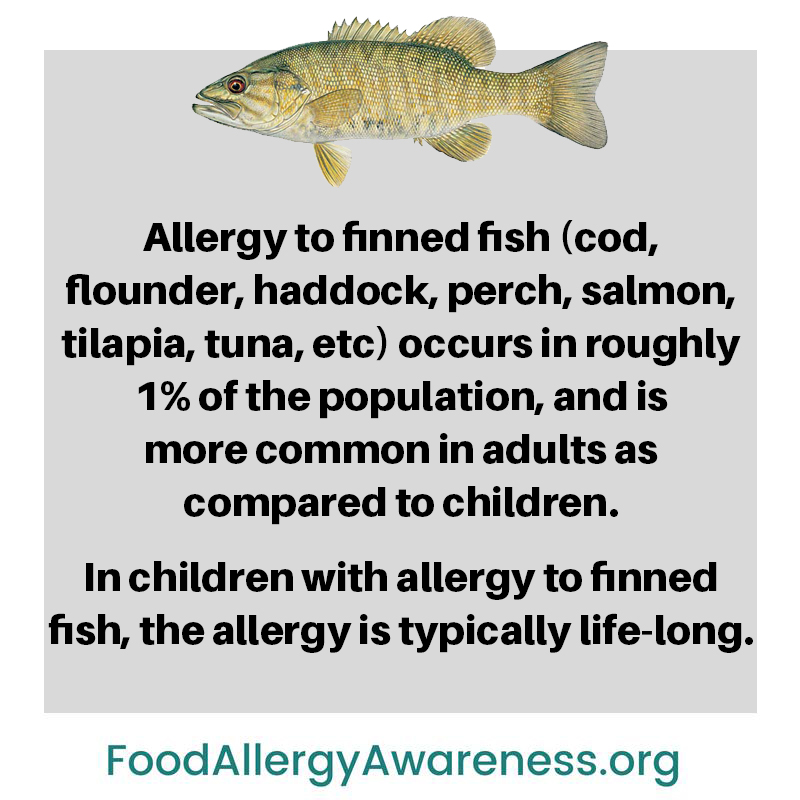
Fish
Allergy to seafood is among the most common food allergies in both children and adults. There are three types of seafood: crustaceans (crab, shrimp, lobster), mollusks (clam, mussel, oyster, scallop), and finned fish (cod, flounder, haddock, perch, salmon, tilapia, tuna, etc). Although shellfish allergy is the most common allergy to seafood, occurring in about 2.5% of adults and 0.5% of children, allergy to finned fish is also a common food allergy.
Allergy to finned fish occurs in roughly 1% of the population, and is more common in adults as compared to children. In children with allergy to finned fish, the allergy is typically life-long. Furthermore, 40-60% of the time the allergy is developed during adulthood, and these individuals are also unlikely to experience resolution of the allergy. Since the allergenic protein (parvalbumin) in finned fish is similar regardless of the type of fish, greater than half of individuals who are allergic to finned fish are allergic to more than one type of fish. Although any type of fish can cause allergy, the most common types implicated in allergy are salmon, tuna, and halibut.
Allergic reactions to finned fish account for a significant percentage of serious allergic reactions to food. Roughly half of reactions require urgent medical evaluation. Death has also been reported from reactions to finned fish. For these reasons, all individuals with allergy to finned fish should carefully read labels and carry epinephrine at all times. It is also important to realize that respiratory and systemic reactions have been reported to exposure to finned fish protein that can become airborne in steam. This is unusual for most allergens and requires particular vigilance for individuals with allergy to finned fish. It is therefore sometimes recommended that individuals with allergy to finned fish avoid seafood restaurants and certain ethnic restaurants where finned fish is being commonly used as an ingredient.
If there is concern for allergy to finned fish, consultation with a board-certified allergist is recommended. Special consideration needs to be made while making the diagnosis, because the method of preparation of the fish may have a significant impact on the allergenicity of the fish. Diagnostic testing, such as skin prick testing, may therefore have a higher than typical rate of false-negative results. Based on the history and evaluation, a physician-supervised oral food challenge may be necessary to make a correct diagnosis. It is also important to differentiate between immune-mediated allergic reactions versus a toxic reaction (scombroid poisoning) or infectious reaction such as food poisoning.
It is also important to note that an allergy to finned fish is not a risk factor for a reaction to radio-contrast media, which is commonly used in imaging studies in medicine (CT scans, MRIs, etc).
Nine foods account for 90 percent of all food allergy reactions:
- Peanuts
- Tree nuts (cashews, pecans, walnuts, etc.)
- Milk
- Egg
- Wheat
- Soy
- Fish (halibut, salmon, etc.)
- Shellfish (crab, lobster, shrimp, etc.)
- Sesame
While more than 170 foods can cause allergic reactions in people with food allergies, the law identifies the nine most common allergenic foods. Visit FAACT's Education Resource Center for FREE and downloadable resources.
Sesame is recognized as the ninth major allergen, effective January 1, 2023, and must be labeled in plain language on packaged foods in the U.S.
References
FDA.gov. (2018). What You Need to Know about Food Allergies. [online]
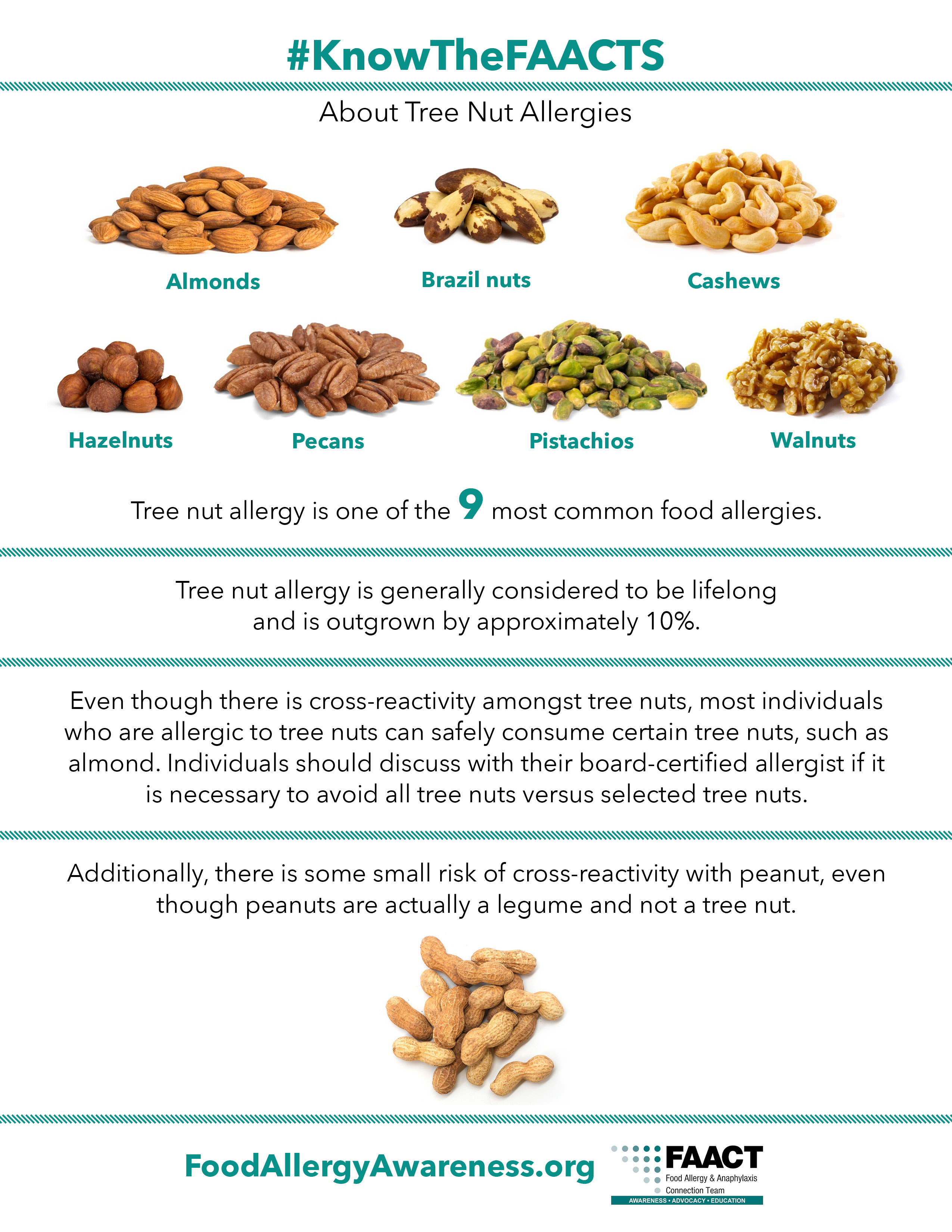
AVOID foods that contain tree nut ingredients, such as:
- Almond
- Brazil Nut
- Cashew
- Hazelnut/Filbert
- Pecan
- Pistachio
- Walnut
- Argan Nut
- Chestnut
- Macadamia Nut*
- Pine Nut (Pignolia Nut)*
Note: while pine (pignolia nut) and macadamia nuts are technically seeds, many allergists recommend avoidance of these items. Please check with your board-certified allergist for specific guidance.
Tree Nuts in Unexpected Places*
- Cereals
- Crackers
- Cookies
- Candy
- Chocolates
- Energy bars
- Flavored coffee
- Frozen desserts
- Marinades
- BBQ sauces
- Nutritional supplements
- Medications
- Cold cuts like Mortadella
- Pet foods
- Bird seeds
- Trail mixes
Download FAACT's Tree Nut Poster here.
Special Considerations
Nut Extracts/Flavoring
Natural extracts such as pure almond extract and wintergreen extract (for the filbert/hazelnut allergy) should be avoided. Imitation or artificially flavored extracts are generally safe. Sometimes it is difficult to determine which is being used in the product, so please check carefully. Gianduja (a creamy mixture of chocolate and chopped almonds and hazelnuts although other nuts may be used), Marzipan (almond paste often used in baking cakes), Nougat, Nu-Nuts, Nutella, pesto, and nut meal. Alcoholic beverages may contain nut flavorings. These beverages are not regulated by the FALCPA (FDA labeling law), and may be more difficult to identify safety of the product. Therefore, it may be necessary to call the manufacturer to determine the safety of ingredients.
Nut Oils
Non-food products may contain tree nut proteins. Look for products that may contain ingredients with nut oils such as almond oil or Moroccan oil (also known as Argan). These and other tree nut oils are commonly found in shampoo, conditioners, cosmetics, lotions and soaps. These may not necessarily need to be avoided because they are not ingested. The risk of sensitization due to use of nut containing oils on the skin or hair is not well-understood, and for some individuals there may be concern. However, for others, this may be perfectly safe. Please discuss use of these products with your allergist.
Atypical Tree Nuts labeled by the FDA
The AAAAI and the FDA differ slightly in what items are classified as tree nuts (the ACAAI’s website uses the FDA’s classification). Avoidance of the following uncommon tree nuts, which are required by US law (FALCPA) to be disclosed on labels, is somewhat controversial:
- Beech Nut
- Ginkgo
- Shea Nut
- Butter Nut
- Hickory
- Chinquapin
- Lychee Nut
- Coconut
- Pili Nut
In general, most individuals with a tree nut allergy can safely eat coconut or coconut oil. However, check with your allergist first to discuss this before trying this on your own, unless the person has long eaten coconut/coconut oil before developing a tree nut allergy. The other nuts listed more closely resemble fruits, and in some cases are considered fruits for culinary purposes.
With regards to nutmeg, water chestnuts and butternut squash, these are not tree nuts and are usually safe to consume. As is the case with coconut, these nuts may not need to be avoided. If you have any concerns regarding the consumption of any of the atypical tree nuts, please discuss this with your allergists. In some cases, proper tests, including a food challenge, may be performed to confirm or disprove an allergy to any of these foods.
*Note: Shea Nut Butter does not pose a risk to tree nut- or peanut-allergic consumer - Food Allergy Research and Resource Program, University of Nebraska-Lincoln (June 2018)
Tree Nut Cross-Reactivity
Tree nuts are very closely related to one another, structurally, as well as share many common proteins with tree pollen. As is denoted in our section on peanut, the same types of similarities and shared proteins also occur between peanut and tree nut. Therefore, on allergy tests, these common proteins and similar structures may be responsible for high rates of co-positive tests among several types of tree nuts, and possibly between tree nut and peanut. Please keep in mind that just having a positive allergy test does not automatically mean that the person is allergic to the item, especially if the person has never eaten the item and developed symptoms. Therefore, a food challenge to the tree nut(s) or to peanut may be recommended to determine if these items are safe to eat. However, some allergists do recommend total avoidance of all peanut and tree nut due to concerns of cross-contact. Tree nuts may be co-manufactured and processed with one another, on shared equipment, and it may be difficult to distinguish one tree nut from one another, visually. Please check with your allergist for your specific management plan.
Other pages that may be of interest:
Visit FAACT's CROSS-CONTACT page to review how to properly clean allergens from hands and surfaces.
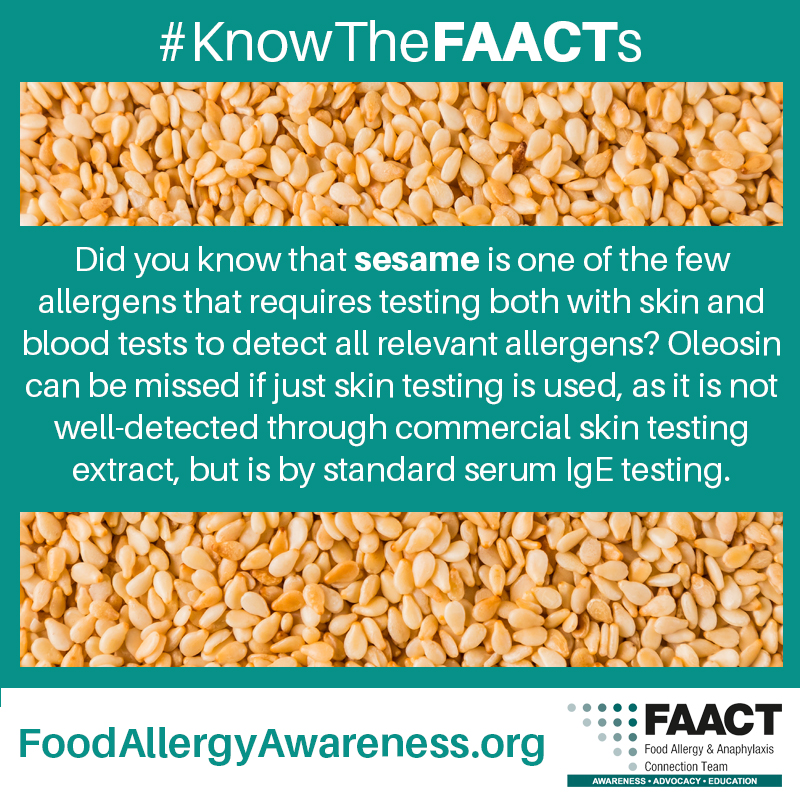
FAACT
Did you know that sesame is one of the few allergens that requires testing both with skin and blood tests to detect all relevant allergens? Oleosin can be missed if just skin testing is used, as it is not well-detected through commercial skin testing extract, but is by standard serum IgE testing.
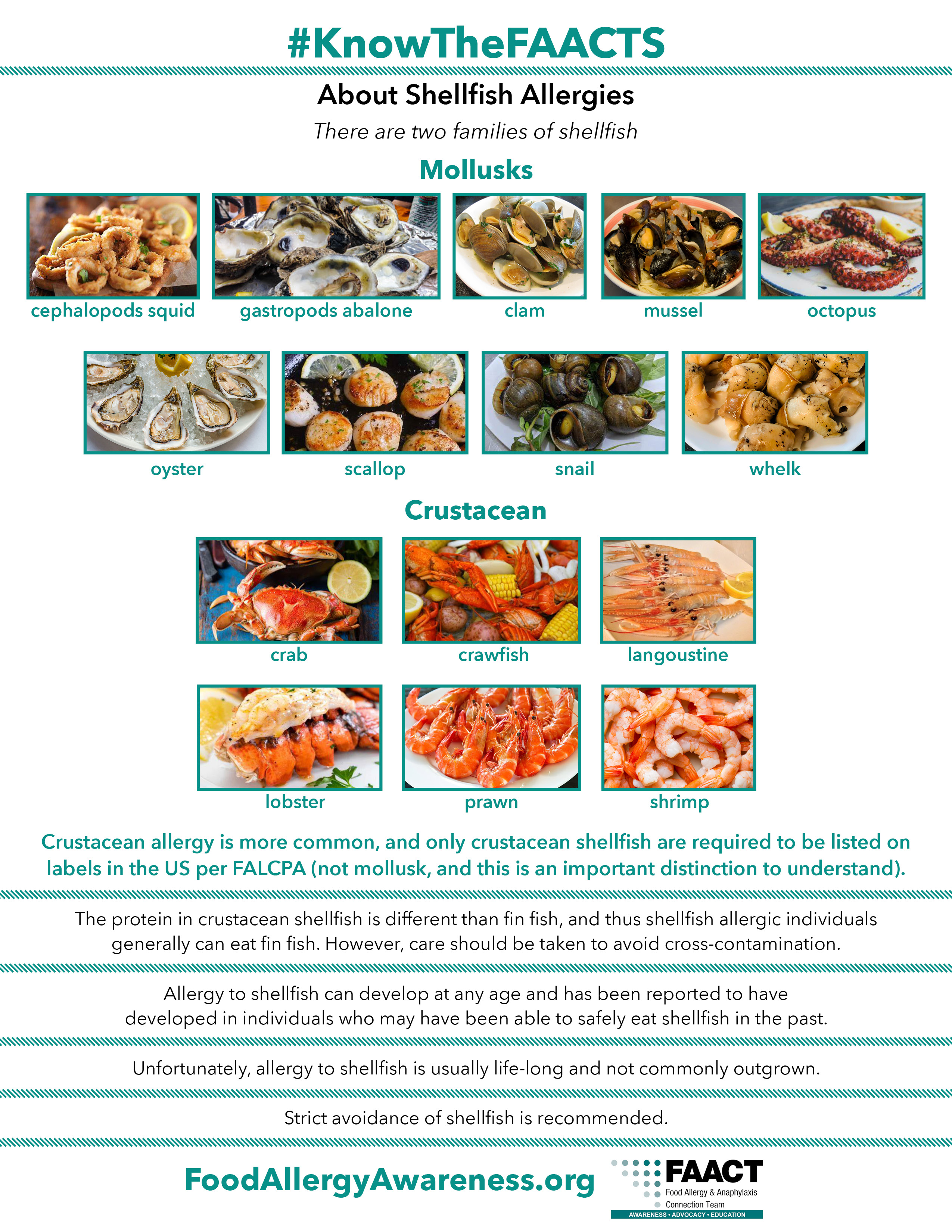
AVOID foods that contain or may contain shellfish ingredients:
The following is a list of words that indicate, or might indicate the presence of shellfish. Shellfish actually contains two categories of food, crustaceans and mollusks:
Crustacean:
- Barnacle
- Crab
- Crawfish (crayfish, ecrevisse)
- Krill
- Lobster (langouste, langousine, scampi, coral, tomalley)
- Prawns
- Shrimp (crevette, scampi)
Mollusks:
- Abalone
- Clams (cherrystone, littleneck, pismo, quahog)
- Cockle (periwinkle, sea urchin)
- Mollusks
- Mussels
- Octopus
- Oysters
- Scallops
- Snails (escargot)
- Squid (calamari)
Other foods that may contain shellfish:
- Bouillabaisse
- Fish Stock
- Seafood Flavorings (such as crab, clam extract)
- Surimi
Download FAACT's Shellfish Poster here.
.jpg)
Types of Finned Fish
- Anchovy
- Bass
- Catfish
- Cod
- Flounder
- Grouper
- Haddock
- Hake
- Halibut
- Herring
- Mahi mahi
- Perch
- Pike
- Pollock
- Salmon
- Snapper
- Sole
- Swordfish
- Tilapia
- Trout
- Tuna
- Walleye
Download FAACT's Fish Poster here.
Practical Tips
It is recommended to always carry at least two (2) epinephrine auto-injectors at all times if you have been diagnosed with a food allergy, including allergy to finned fish. This is in case one misfires or if symptoms recur and a second dose is needed. If an epinephrine auto-injector has been used, always seek emergency medical assistance immediately. This is due to the possibility of a biphasic reaction. A biphasic reaction is when a second wave of symptoms occurs. This typically happens from 2-6 hours following the initial reaction.
Read all product labels prior to the consumption of a new food product. Before consuming any products, it is important to always read labels carefully to ensure the safety of food products. All food products that contain fish protein as an ingredient are required by FALCPA law to list the specific fish on the product label. Please note, manufacturing practices may change without notice. According to the Food Allergen Labeling and Consumer Protection Act (FALCPA), food products with the advisory statements such as “may contain,” “processed in the same plant,” or “manufactured on the same line” on a package are completely voluntary, and can be ambiguous. The true level of contamination is not declared, and may range from parts per million to micrograms. There may be different risks associated with these levels. It is generally recommended to avoid products with such labeling because of this uncertainty, but you should discuss with your allergist which particular labels should be avoided.
Visiting restaurants can be a pleasant experience for family and friends to gather together. However, some restaurants may pose as a risk. Seafood and ethnic restaurants are considered high risk for individuals with allergy due to finned fish. Individuals also need to be aware of the risk of respiratory or systemic reactions to airborne protein. Please review our restaurant page for tips on how to manage visiting a restaurant. Be vigilant, ask questions, and if there is any doubt, don’t eat the food item in question.
AVOID foods that contain or may contain fish ingredients, such as:
Caesar dressing
Caesar salad
Bouillabaisse
Imitation crab
Fish stock
Seafood flavorings
Worcestershire sauce
Other pages that may be of interest:
Visit FAACT's CROSS-CONTACT page to review how to properly clean allergens from hands and surfaces.
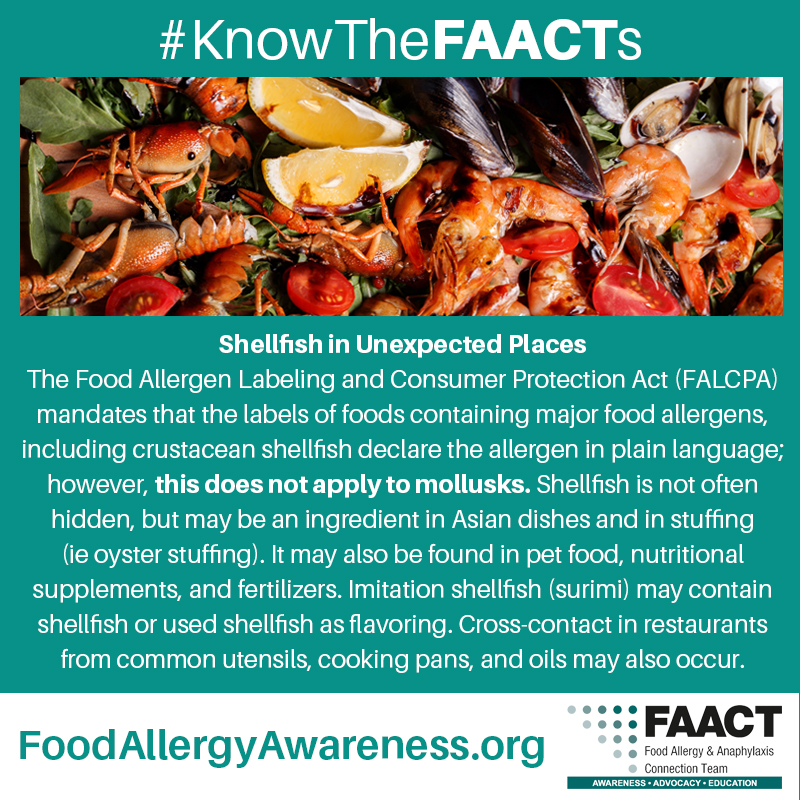
Shellfish in Unexpected Places*
The Food Allergen Labeling and Consumer Protection Act (FALCPA) mandates that the labels of foods containing major food allergens, including crustacean shellfish declare the allergen in plain language; however, this does not apply to mollusks.
Shellfish is not often hidden, but may be an ingredient in Asian dishes and in stuffing (ie oyster stuffing). It may also be found in pet food, nutritional supplements, and fertilizers. Imitation shellfish (surimi) may contain shellfish or used shellfish as flavoring. Cross-contact, as mentioned earlier, in restaurants from common utensils, cooking pans and oils may also occur.
Other pages that may be of interest:
Visit FAACT's “CROSS-CONTACT” page to review how to properly clean allergens from hands and surfaces.
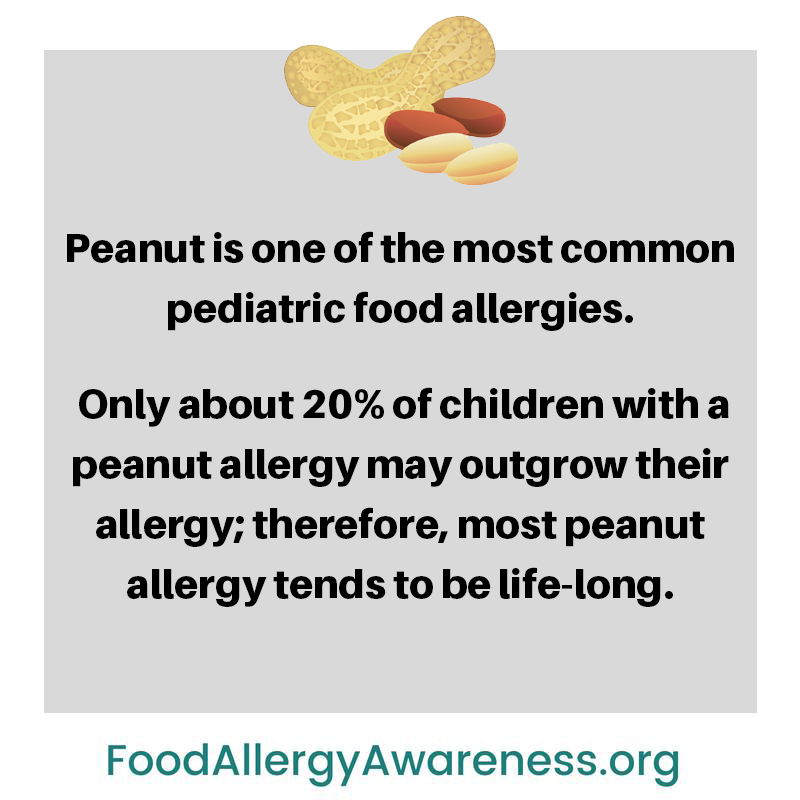
Peanut
Peanut is one of the most common pediatric food allergies.[1] Between 1997-2008, the self-reported rate of peanut allergies tripled from about 0.4% to 1.4%. A 2011 study suggested as many as 2% of children may have peanut allergy. Only about 20% of children with a peanut allergy may outgrow their allergy; therefore, most peanut allergy tends to be life-long. Peanut allergy may results in severe reactions—a 2011 study noted that more than half of those reporting a peanut allergy also reported having a severe reaction to peanut. Therefore, peanut avoidance is exceptionally important. Though not much is known about why individuals die from food allergy, among known cases of such deaths, many of these individuals died from peanut allergy. Please review the “Practical Tips” section for ways to manage peanut allergies if you have been diagnosed.
There are no good answers as to why so many people are developing peanut allergies. One possible theory may relate to how peanut is prepared. In certain parts of the world, peanuts are boiled and fried as opposed to being dry roasted (or defatted to become peanut butter) as is common in the US. Tests have shown that dry roasting and defatting may make peanut more dangerous as an allergen than when it is simply boiled. When peanut is introduced in the diet may also play a role. Data from a study conducted in Israel (where peanut is introduced in the first year of life) and London (where it is delayed until age 3) noted that there were lower rates of allergy in Israel, which was thought to be related to the earlier introduction. This theory is currently being investigated in a large trial in London.
Peanut Allergy: Special Considerations
The need for tree nut avoidance:
Individuals with a peanut diagnosis should seek a board certified allergist recommendation to confirm avoidance of tree nuts due to a peanut allergy. Peanut and tree nut are not from the same family. Peanut is a legume, and tree nuts are drupes. Because both peanut and tree nut have evolved from plants, each carries certain proteins that are shared between peanut, tree nut, and other plants. However, there are other parts of peanut and tree nut that are very similar in structure. On allergy tests, the common proteins and similar structures may be responsible for high rates of co-positive tests when assessing peanut and tree nut individuals for cross-reactivity. Please keep in mind that just having a positive allergy test does not automatically mean that the person is allergic to the item, especially if the person has never eaten the item and developed symptoms. Therefore, a food challenge to the tree nut(s) may be recommended to determine if these items are safe to eat. However, some allergists do recommend total avoidance of all peanut and tree nut due to concerns of cross-contamination. Please check with your allergist for your specific management plan.
The safety of peanut oils:
The safety of peanut oils is controversial. In general MOST (but not all) peanut oil used for cooking purposes is safe. Highly refined commercial peanut oils have been shown to not contain any peanut, and may be considered safe. However, cold pressed and smaller batch peanut oils have been shown to contain varying levels of peanut, and thus are not considered safe. It is difficult to identify the type of oil used to cook a product, however. Therefore, avoidance of peanut oil is often recommended, though it is likely that some peanut allergic patients have tolerated peanut oil. We realize that this may be very confusing, and that more studies are needed to clarify if peanut oils are safe. Please discuss the safety of peanut oils with your board-certified allergist or doctor managing your peanut allergy.
The risk of inhaling peanut and casual environmental contact:
Caregivers and patients often express concern about reacting to peanut through the smell of peanut butter, breathing in peanut dust, or the risk from touching surfaces that may have come in contact with peanut. Inhalation has often been reported as a route through which someone’s reaction has occurred. However, evidence has shown there is a very low to absent risk accidental exposure through casual environmental contact is exceptionally low, and no evidence that shows peanut butter or peanut dust can cause a reaction. Studies have shown that following:
-
Peanut residue can be easily cleaned from hands with soap and water (not hand gel) and from tables with commercial products.
-
Inhaling the scent of peanut butter (within a foot of an open jar) did not cause any reactions.
-
No peanut allergen could be measured at the level of the neck after volunteers stomping on whole peanuts in a small room with no ventilation
-
When actively shelling peanuts, peanut allergen could only be detected 2 cm above the table. However, allergen was not detectable 1m away, and undetectable at either 2cm or 1m immediately upon stopping shelling.
Practical Tips
It is recommended to always carry at least two (2) epinephrine auto-injectors at all times if you have been diagnosed with a peanut allergy. This is in case one misfires or if symptoms return and a second dose is needed. If an epinephrine auto-injector has been used, always seek emergency medical assistance immediately. This is due to the possibility of a biphasic reaction. A biphasic reaction is when a second wave of a reaction occurs, which is usually stronger than the first. It can occur within 2-4 hours and in some cases, up to 8 hours, after the initial reaction. Stay in medical care for at least 4-6 hours. Strict avoidance of peanuts and products containing peanuts is necessary.
Read all product labels prior to the consumption of a new food product. Before consuming any products, it is important to always read labels carefully to ensure the safety of a food product. All food products that contain peanut protein as an ingredient are required by FALCPA law to list the word “Peanut” on the product label.[2] The following ingredients may indicate the presence of peanut protein. Please note, manufacturing practices may change without notice. According to the Food Allergen Labeling and Consumer Protection Act (FALCPA), food products with the advisory statements such as “may contain”, “might contain”, or “manufactured in a shared facility that process” on a package are completely voluntary, and can be ambiguous. The true level of contamination is not declared, and may range from parts per million to micrograms. There may be different risks associated with these levels. It is generally recommended to avoid products with such labeling because of this uncertainty.
Cross-contamination from cooking utensils or products like using the same jelly that was used in making a peanut butter and jelly sandwich pose a potential danger. If a knife that was used in the peanut butter was then used in the jelly, the jelly is no longer safe for the peanut allergic individual. A new, clean knife should have been used in the jelly jar (no double dipping). Or a separate, dedicated jelly for the peanut allergic individual may be a safer option. Another example is scraping off peanuts from a meal and serving it to a peanut allergic individual. It is still unsafe for consumption. A new clean plate, with a safe meal, should be served to the peanut allergic individual.
Many tree nuts (almonds, walnuts, pistachio etc.) may be processed with peanut and contain trace amounts of peanut protein if these are not from a single-source facility. In addition, candies and chocolates may be processed with peanuts, and contain trace amounts of peanut protein. Be mindful of smaller or “fun size” version of the larger products. These products are often times manufactured on different equipment and may be exposed to the peanut allergen during this process that are not present in the larger sized bars. It is recommended to read labels and contact the manufacturer to confirm the safety of the products.
Visiting restaurants can be a pleasant experience for family and friends to gather together. However, some restaurants may pose as a risk. Ethnic restaurants (such as Chinese, African, Indian, Thai and Vietnamese), ice cream shops and bakeries are considered high risk for individuals with a peanut allergy due to the common use of peanuts as ingredients, as well as the risk of cross-contaminated cooking surfaces and utensils. Please review our restaurant page for tips on how to manage visiting a restaurant. Be vigilant, ask questions, and if there is any doubt, don’t eat the food item in question.
How to safely avoid peanut
Peanuts can be found in everyday food items. It is important to identify the safety of each item.
We have designated two areas of concern:
1. Foods that commonly use or may contain peanut as an ingredient, so be EXTRA-CAUTIOUS and investigate these products carefully before allowing a peanut-allergic individual to eat them.
2. Foods where peanut can be used as a hidden or unexpected ingredient, so be EXTRA-CAUTIOUS and investigate these products carefully before allowing a peanut-allergic individual to eat them.
Foods that commonly contain or may contain peanut as an ingredient:
- Candies
- Chocolates
- Baked Goods
- Ice Cream
- Trail Mixes
- Specialize candied popcorn (Cracker Jacks and other brands)
- Peanut oils*: Arachic, Arachis, Cold pressed, Expressed, Expelled, Extruded peanut
Foods that may contain peanut as a hidden or unexpected ingredient:
- Egg roll (used binding agent)
- Pet food
- Bird Seed
- Crepe filling
- Mole Sauce
- Served as waiting area appetizers at certain chain restaurants
- Glazes and marinades
- Graham cracker crusts
- Nougat
- Chili sauces
- Hot sauces
- Pesto
- Gravy
- Some salads may contain peanut
*It is important to check the safety of the products listed. However, some products listed may have safe alternatives. For example, some pancakes are safe for peanut allergic individuals. It is best to check with the manufacturer or restaurant to confirm the safety.
Other pages that may be of interest:
Visit FAACT's CROSS-CONTACT page to review how to properly clean allergens from hands and surfaces.
.jpg)
FAACT
According to the U.S. FDA’s label law, Food Allergen Labeling and Consumer Protection Act (FALCPA), all manufactured food products in the United States containing tree nut ingredients are required to be listed by the specific tree nut on a product label.[3]
FAACT
Did you know that people who are allergic to shellfish are NOT at any increased risk of allergic reactions to iodine or radiocontrast media? This is one of the largest myths that still persist, costing the healthcare system millions of dollars.
It is rare, but possible, for aerosolized shellfish allergen, to cause symptoms. This can happen from cooking and smelling vapors, or from restaurant workers or shellfish processers with frequent close exposure to these items.
References
[1] NLM/NIH MedlinePlus http://www.nlm.nih.gov/medlineplus/ency/article/002467.htm
[1] NLM/NIH MedlinePlus http://www.nlm.nih.gov/medlineplus/ency/article/002403.htm
J Fam Pract. 2010 Jun;59(6):314, Schabelman E, Witting M.
J Emerg Med. 2010 Nov;39(5):701-7. doi: 10.1016/j.jemermed.2009.10.014. Epub 2010 Jan 4. Reviewer et
1.Lopata AL, Jeebhay MF. Airborne seafood allergens as a cause of occupational allergy and asthma. Curr Allergy Asthma Rep. 2013 Jun;13(3):288-97. doi: 10.1007/s11882-013-0347-y. Review.
2. Griffin P, Allan L, Gibson M, Elms J, Wiley K, Curran AD. Measurement of personal exposure to aerosols of Nephrops norvegicus (scampi) using a monoclonal-based assay. Clin Exp Allergy. 2001 Jun;31(6):928-33.
Relevant Citations
Lopata Al, Oheihir RE, Lehrer SB. Shellfish Allergy. Clin Exp Allergy 2010; 40: 850-58.
Sicherer SH, Munoz-Furlong A, Sampson HA. Prevalence of seafood allergy in the United States determined by a random telephone survey. J Allergy Clin Immunol 2004; 114:159–65.
Lau Ch, Springston EE, Smith B, Pongracic J, Holl JL, Gupta RS. Parent report of childhood shellfish allergy in the United States. Allergy Asthma Proc 2012; 33: 474-80.
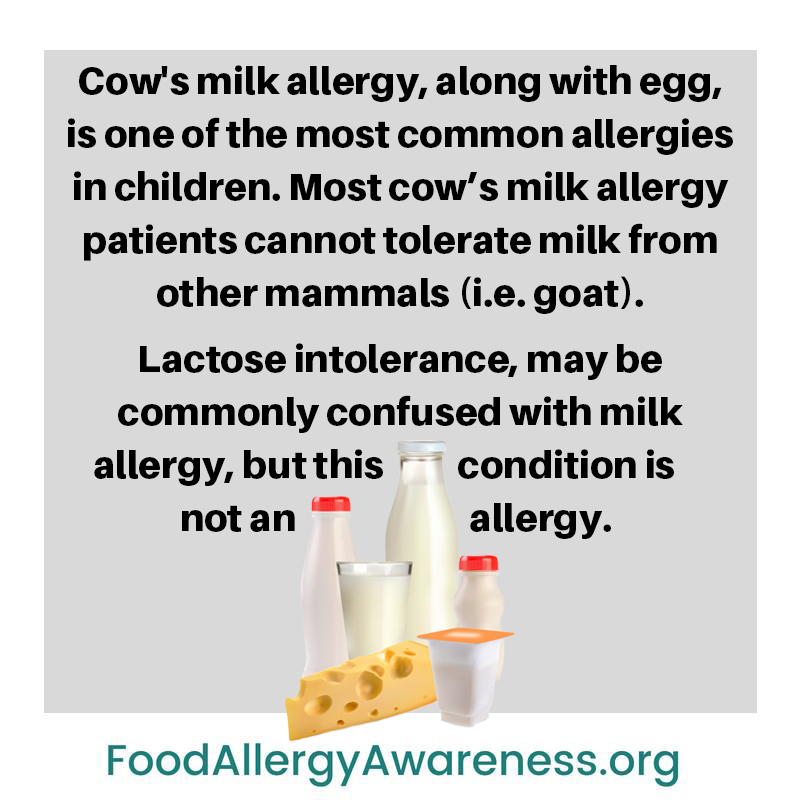
Milk Allergy
Cow's milk allergy, along with egg, is one of the most common allergies in children. It is an IgE antibody-mediated reaction to proteins in cow’s milk. It was once thought that infants and children will outgrow their milk allergy prior to elementary school age. However, some milk (and egg) allergic infants and children keep these allergies well into the school years and beyond according to one large study. Studies have shown about 75% of individuals may tolerate small amounts of cow’s milk protein in extensively heated milk, such as in baked goods.
Most cow’s milk allergy patients cannot tolerate milk from other mammals (i.e. goat). Approximately 90% of cow’s milk allergic patients will react to goat and/or sheep’s milk. Many milk allergic infants will tolerate soy formula, but soy is a major allergen with an independent rate of allergy, and some doctors elect to try a different type of formula. Infants with cow’s milk allergy may tolerate extensively hydrolyzed formulas containing minimal residual amounts of milk. A substitution with an elemental formula is the most conservative management, and may be your doctor’s recommendation. Because of the different needs of each milk allergic child, please seek the assistance of a board certified allergist to find the correct formula that will assist with the milk allergic child’s developmental stage.
To confirm milk allergy, an Oral Food Challenge (OFC) can be performed in a clinical setting with a board certified allergist. OFC’s are also used to confirm when milk allergy is outgrown. Please consult with a board certified allergist for further instructions on cow’s milk in baked goods OFC, as risks may be involved, or whether the allergic individual should continue to avoid milk.
Lactose intolerance, may be commonly confused with milk allergy, but this condition is not an allergy. In lactose intolerance, individuals cannot digest the sugars (lactose) in the milk because they have a deficiency of the lactase in the lining of the gut, which leads to abdominal cramps, gas or diarrhea. This is not an immunologic reaction. In milk allergy, patients can experience cramping or diarrhea similar to lactose intolerance.
Milk can be an important source of protein, calcium, vitamin D and vitamin B12. In order to replace these dietary needs, allergic individuals may need to look at other food sources. A consultation with a pediatric nutritionist, who has experience with food allergies, may also be helpful to ensure balanced and adequate nutrition is achieved.[1]
Other Sources of Protein[6] - (it may be necessary to seek the assistance of a nutritionist to be sure the allergic individual is receiving the proper balance of amino acids).
- Meat
- Fish*
- Egg*
- Soy*
- Beans*
- Legume*
- Grains* (such as wheat germ)
Other Sources of Calcium[3]:
- Leafy Green Vegetables
- Broccoli
- Collards
- Kale
- Mustard Greens
- Turnip Greens
- Bok Choy or Chinese Cabbage
- Almonds*
- Brazil Nuts*
- Sunflower Seeds*
- Tahini*
- Dried Beans*
- Fortified juices (read labels)
Other Sources of Vitamin D[4]:
- Fatty Fish* (tuna, salmon, mackerel)
- Oysters*
- Supplements* (be aware that some supplements contain milk)
Other Sources of Vitamin B12[5]:
- Eggs*
- Fortified Foods
- Meat
- Organ Meats (liver and kidney)
- Poultry
- Shellfish*
*Be aware these are the most common allergenic foods. However, almost any food can cause an allergic reaction. It is recommended to speak with a board certified allergist before adding any new foods to the allergic individual’s diet.
Practical Tips
It is recommended to always carry at least two (2) epinephrine auto-injectors at all times if you have been diagnosed with a milk allergy. This is in case one misfires or if anaphylaxis is aggressive and a second dose is warranted. If an epinephrine auto-injector has been used, seek emergency medical assistance immediately. Strict avoidance of milk and products containing milk is necessary.
Read all product labels prior to the consumption of a new food product. According to the Food Allergen Labeling and Consumer Protection Act (FALCPA), food products with the advisory statements such as “may contain” or “manufactured in facility that process” on a package are voluntary. These statements are one in the same and manufacturers are not required to include these advisory statements. Whether or not the statement appears on a product has no baring on the safety. The absence of the statement does not necessarily mean that products may have not been exposed to cross contact. Cross-contact is when a food item has been manufactured on a shared equipment with an allergen, for example milk, during the manufacturing process. Contacting the manufacturer to confirm safety of a product is recommended.
Other ways of cross-contact (sometimes referred to as cross contamination) occurs when utensils between a safe food has been shared with an unsafe food. For example, shared cooking utensils or products, like using the same spoon in a sugar container that was used to stir a cup of coffee that had creamer in it. The sugar container is now contaminated and no longer safe for the milk allergic individual. A new container of sugar should be opened and a new spoon should be used. Cooking utensils should be thoroughly washed with soap and water.
AVOID foods that contain milk ingredients, such as:
- Artificial butter flavor, butter fat, butter oil
- Butter
- Casein and caseinates (in all forms)
- Cheese (all types)
- Cream
- Curds
- Custard
- Ghee
- Hydrolysates (casein, milk protein, protein, whey, whey protein)
- Ice Cream
- Lactalbumin, lactalbumin phosphate, lactoglobulin, lactoferrin, lactulose
- Milk
- Nougat
- Pudding
- Rennet, rennet casein
- Recaldent (TM) (used in teeth-whitening chewing gums)
- Simpless (R)
- Whey (in all forms)
- Yogurt
Milk in Unexpected Places*[2]
- Margarines
- Breads
- Cookies
- Cakes
- Chewing Gum
- Chocolates
- Cold Cuts
- Crackers
- Cereal
- Non-dairy Products
- Processed and Canned Meats
- Frozen and Refrigerated Soy Products
- Sheep Milk
- Goat’s Milk
- Deli Meats (due to cross contact from slicing cheese and meats on the same machine)
- Kosher Dairy (“D” next to the circled “K” or “U” indicates the presence of milk protein and must be avoided.)
- Kosher (Parve or pareve indicates foods not suppose to contain milk. However, foods may be considered “pareve” even if it contained a small amount of milk protein. For some this can be potentially risky, enough to cause an allergic reaction, and must be avoided.)
- Cosmetics
- Nutritional Supplements
- Medicines
- Pet Foods
Other pages that may be of interest:
Visit FAACT's CROSS-CONTACT page to review how to properly clean allergens from hands and surfaces.
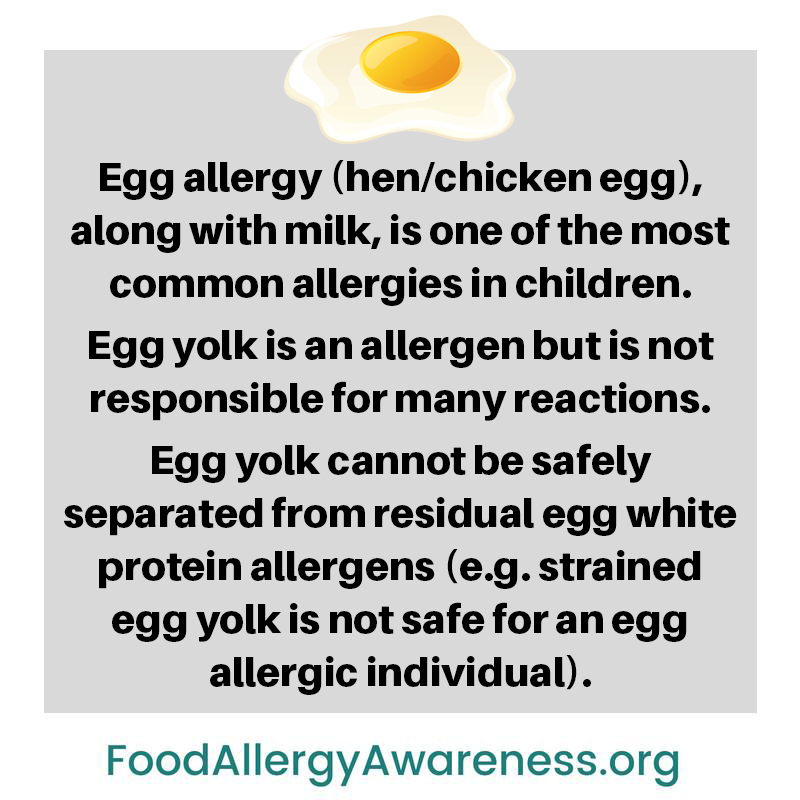
Egg
Egg allergy (hen/chicken egg), along with milk, is one of the most common allergies in children.
There are as many as 23 proteins in egg, but most of the allergens are in the egg white, not the egg yolk. There are three major proteins of concern in egg white: ovalbumin, the major allergen present in the highest proportion; ovomucoid, another egg white protein responsible for the majority of allergic reactions; and ovotransferrin. Egg yolk is an allergen but is not responsible for many reactions. Egg yolk cannot be safely separated from residual egg white protein allergens (e.g. strained egg yolk is not safe for an egg allergic individual).
Egg allergy is unique in that 70 to 80 percent of egg-allergic patients may tolerate egg that has undergone extensive baking (greater than 350 degrees F for 30 minutes, called “baked egg”) and are thus able to consume baked egg in pastries, breads, and cakes. Ovalbumin in particular is broken down and not able to bind IgE after such heating. However, ovomucoid is heat-stable, and patients who are allergic to ovomucoid tend to not tolerate baked egg. One study noted that patients who were baked-egg tolerant and regularly consumed baked egg were able to tolerate all forms of egg faster than those who could not tolerate baked egg. Wheat in baked goods may prevent the egg from being absorbed and recognized by the body.
Egg allergy is generally outgrown in childhood. One study showed that 66 percent of egg-allergic children tolerated egg by age 5, although nearly one-third of children with high egg-specific IgE levels and children with other food allergies may still need to avoid eggs at 16 years of age.
To confirm egg allergy, an Oral Food Challenge (OFC) can be performed in a clinical setting with a board-certified allergist. OFC’s are also used to confirm tolerance of baked egg. Consult with a board-certified allergist for further instructions on preparing egg in baked goods and the timing of either a baked egg or egg OFC – risks may be involved, and not all patients are proper candidates. In an Australian study of one-year-olds, 80 percent of children who failed a food challenge to egg were tolerant of baked egg. However, the best time to attempt a baked egg challenge is unclear.
Baked Egg Diet: What Is and Is Not OK?
It is essential to discuss with your allergist before introducing baked egg, since it is possible that eating foods containing baked egg may result in anaphylaxis. Check with your allergist or dietician for more specific guidelines, but in general, published data indicates the following guidelines[1]:
Allowed:
-
Egg listed as the third ingredient or lower on the ingredient list.
-
Home-baked items cooked at a minimum of 350 degrees F for at least 30 minutes that contain no more than two eggs per recipe batch.
- Home-baked goods with a thoroughly cooked center (not moist/soft). Individual sized products (cupcake, brownie, muffin, etc.) are generally preferred to pieces of larger, full sized items because it is easier to make sure the center is fully cooked.
Not Allowed:
- Caesar salad dressing
- Custard
- Egg listed as the first or second ingredient
- French toast
- Frosting
- Home-baked goods in full-sized products (cookies, cakes, pans of brownies) where it is hard to tell if the center is cooked through
- Home-baked products with more than two eggs per recipe batch
- Ice cream
- Mayonnaise
- Meringue cookies
- Pan-cooked egg of any style
- Pancakes made from scratch or a mix
- Quiche
Egg is an important source of dietary fat and protein. To replace these dietary benefits, egg-allergic individuals may need to look at other food sources. A consultation with a nutritionist who has experience with food allergies may also be helpful to ensure balanced and adequate nutrition.
Other Sources of Protein
- Beans*
- Fish*
- Grains* (such as wheat germ)
- Legumes*
- Meat
- Milk*
- Soy*
Other Sources of Fat:
- Avocado
- Dairy products including butter, whole, or 2 percent milk*
- Fatty fish*
- Meat products
- Nuts*
- Polyunsaturated and monounsaturated fatty acids (vegetable oils such as olive, canola, safflower, sunflower, soy, corn, peanut, and cottonseed oil)
- Seeds*
* These are among the most common allergenic foods. However, almost any food can cause an allergic reaction. Check with a board certified allergist before adding any new foods to your.
Avoid foods that contain egg ingredients, such as:
- Albumin
- Egg (white, yolk, dried, lecithin, powdered, solids)
- Egg substitutes
- Egg nog
- Egg noodles
- Globulin
- Lysozyme (used in Europe)
- Mayonnaise
- Meringue
- Ovalbumin
- Ovovitellin
- Surimi
Egg in Unexpected Places
- Shiny coats/glazes on pastries/candies. These may be egg washes. Candy dots, lollipops, and soft pretzel glazes are possible examples of this.
- Many egg substitutes may contain egg.
- Many pastas sold in stores contains egg, both dried and fresh.
- Foams on coffee drinks may contain egg.
- Egg white and egg yolk cannot be separated without cross-contamination.
- Lecithin (most soy lecithin does not contain egg, but double check).
- Marshmallows, marzipan, and nougat may contain egg.
Egg-Containing Vaccines: FAACTs to Know
Influenza vaccine (injectable and nasal) and the Measles, Mumps, Rubella (MMR) vaccine have been repeatedly shown to be safe even in individuals with egg allergy. There is still a general precaution for Yellow Fever vaccine that remains unchanged. Since 1995, the MMR vaccine has been considered safe for all egg-allergic recipients and should be routinely administered in the primary care setting. Since 2011 the CDC and AAAAI/ACAAI both have recommended that egg allergic individuals receive influenza (prior to this it was often withheld or only given at an allergist’s office under a special procedure). Furthermore, allergy testing to the vaccine and multiple dose vaccine desensitizations are no longer necessary. Injectable influenza vaccine is safe to egg-allergic children of any severity (including egg anaphylaxis) as a single dose, without testing to the vaccine. However, at this time, the CDC and American Academy of Pediatrics recommend that only egg-allergic children with a history of developing just hives after consuming egg should receive the influenza vaccine in the primary care setting (e.g with their pediatrician), and that patients with a more severe history of reactivity should receive the vaccine from a board-certified allergist. However, to repeat, influenza vaccine is safe for any individual, including those with past severe reactions to egg, despite recommending that only the children with very mild past reactions to egg receive this in the primary care setting.
Practical Tips
-
Avoid egg and products containing egg.
-
Always carry at least two (2) epinephrine auto-injectors at all times if you have been diagnosed with an egg allergy. This is in case one misfires or if symptoms return and a second dose is needed.
-
Seek emergency medical assistance immediately after using an epinephrine auto-injector. This is due to the possibility of a biphasic reaction. A biphasic reaction is when a second reaction occurs due to the initial allergen exposure. Stay in medical care for at least 4-6 hours.
-
Read all product labels prior to eating a new food product. According to the Food Allergen Labeling and Consumer Protection Act (FALCPA), food products with advisory statements such as “may contain” or “manufactured in facility that processes” are voluntary. Manufacturers are not required to include these advisory statements. Whether or not the statement appears on a product has no bearing on the product’s safety. The absence of the statement also does not necessarily mean that product may have not been exposed to cross-contact. Cross-contact is when a food item has been manufactured on shared equipment with an allergen (for example, egg) during the manufacturing process. Contact the manufacturer to confirm the safety of a product.
-
Cross-contact can also occur when utensils or equipment are shared, such as cooking and serving utensils. For example, a spatula that was used to cook pancakes or a knife used to spread mayonnaise. These utensils are now contaminated and no longer safe for an egg-allergic individual.
-
Cooking utensils should be thoroughly washed with soap and water after each use.
Visiting restaurants can be a pleasant experience for family and friends to gather together. However, some restaurants may pose a food-allergy risk. There is also the risk of cross-contact even if an egg-free item is ordered. Please visit our Restaurant Web page for tips on how to manage visiting a restaurant.
Other pages that may be of interest:
Visit FAACT's CROSS-CONTACT page to review how to properly clean allergens from hands and surfaces.
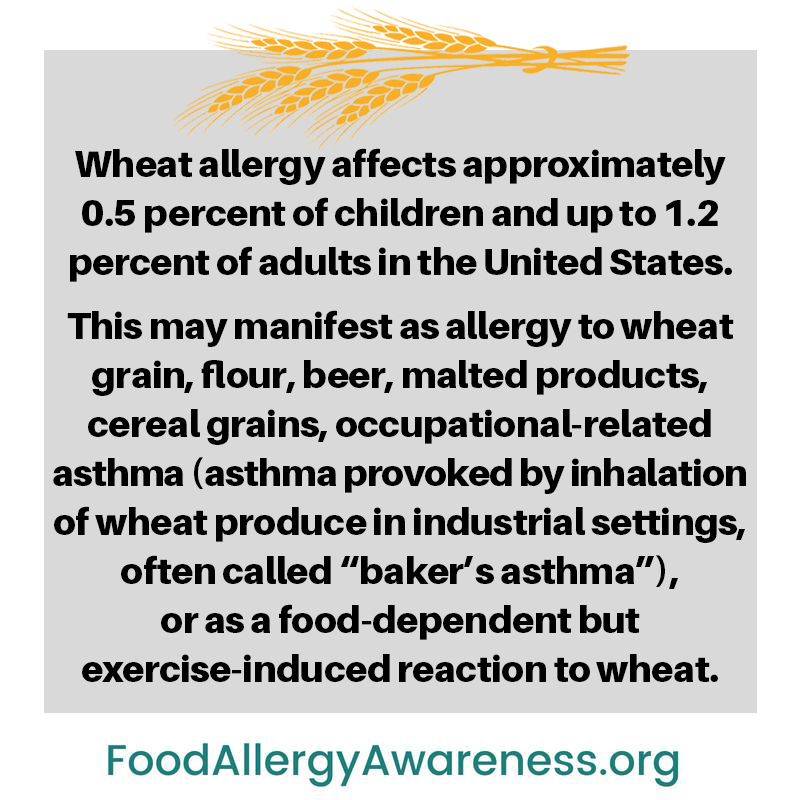
Wheat
Wheat allergy affects approximately 0.5 percent of children and up to 1.2 percent of adults in the United States. This may manifest as allergy to wheat grain, flour, beer, malted products, cereal grains, occupational-related asthma (asthma provoked by inhalation of wheat produce in industrial settings, often called “baker’s asthma”), or as a food-dependent but exercise-induced reaction to wheat.
Wheat allergens are highly cross-reactive with other grains and grass pollen. This may, from time to time, cause wheat allergic persons to have positive allergy testing to multiple other grains, though they can eat these grains without any symptoms. Gliadin and gluteiin are the major wheat allergens associated with IgE-mediated allergy.
Wheat allergy may be confused with Celiac disease, especially since both involve a reaction to gluten. However, Celiac disease is not the same thing as IgE-mediated wheat allergy. Celiac disease is an auto-immune disease of the gut involving IgA and IgG antibodies that form against gliadin but does not involve mast cells or IgE (i.e., non-IgE mediated allergy), and results in symptoms such as intestinal malabsorption, greasy, smelly diarrhea; abdominal pain; and bloating. In contrast, wheat allergy involves an IgE mediated reaction to gliadin and several other wheat proteins, which can trigger anaphylaxis and other allergic symptoms. Unlike in a wheat allergy, those with Celiac disease need to avoid rye, barley, and gluten-containing oat in addition to wheat. Therefore, gluten-free foods are safe for someone with wheat allergy, but wheat-free foods may not be safe for someone with Celiac disease. People who suspect they may have Celiac disease should consult a gastroenterologist.
Wheat allergy is generally outgrown in childhood. One study found that 56 percent of patients outgrew wheat allergy by age 8 and 65 percent outgrew it by age 12. Higher levels of wheat-specific IgE may indicate a lower chance of outgrowing wheat allergy, but wheat-specific IgE has not proven to be as reliable a marker as IgE for other allergens such as peanut, egg, or milk.
Wheat is also a common trigger in an unusual form of food allergy known as food-dependent, exercise-induced anaphylaxis. Symptoms of this condition are similar to symptoms of anaphylaxis but occur when exercising only after having eaten a trigger food like wheat. People with this condition are advised to exercise 2-4 hours or longer after eating their trigger food. This condition is likely due to altered absorption of an allergenic food during exercise. This is a rare form of anaphylaxis, but it is more common in women in their teens to mid-30s. A strong clinical history and possibly a food/exercise challenge can help diagnose this.
To confirm wheat allergy, an Oral Food Challenge (OFC) can be performed in a clinical setting with a board-certified allergist. Consult with a board-certified allergist for further information on performing a wheat OFC – risks may be involved, and not all patients are proper candidates.
Practical Tips
-
Avoid products containing wheat.
-
Always carry at least two (2) epinephrine auto-injectors at all times if you have been diagnosed with a wheat allergy. This is in case one misfires or if symptoms return and a second dose is needed.
-
Seek emergency medical assistance immediately after using an epinephrine auto-injector. This is due to the possibility of a biphasic reaction. A biphasic reaction is when a second reaction occurs due to the initial allergen exposure. Stay in medical care for at least 4-6 hours. Read all product labels prior to eating a new food product. Advisory statements found on food products such as “may contain” or “manufactured in facility that processes” are voluntary. Manufacturers are not required to include these advisory statements. Whether or not the statement appears on a product has no bearing on the product’s safety for people with food allergies. The absence of the statement also does not necessarily mean that product may have not been exposed to cross-contact. Cross-contact is when a food item has been manufactured on shared equipment with an allergen (for example, wheat) during the manufacturing process. Contact the manufacturer to confirm the safety of a product.
-
Cross-contact can also occur when utensils or equipment are shared, such as cooking and serving utensils. For example, a spatula used to cook pancakes, a spoon used to stir a baking mix, or common surfaces or trays used for kneading or baking dough. These utensils/surfaces are now contaminated with wheat and no longer safe for a wheat-allergic individual.
-
Cooking utensils should be thoroughly washed with soap and water after each use.
Visiting restaurants can be a pleasant experience for family and friends to gather together. However, some restaurants may pose a food-allergy risk. Restaurants, ice cream shops, candy shops, and bakeries are considered high risk for individuals with a wheat allergy due to the common use of wheat in foods here. There is also the risk of cross-contact even if a wheat-free item is ordered. Please visit our Restaurant Web page for tips on how to manage visiting a restaurant.
AVOID foods that contain wheat ingredients, such as:
- Bread and bread crumbs (unless specifically labeled wheat-free)
- Bulgur
- Cereal extract (a flavor enhancer)
- Couscous (a coarsely ground pasta made from semolina wheat)
- Durum (durum flour or wheat)
- Emmer wheat (also known as farro)
- Einkorn wheat
- Farina
- Flour (all-purpose, cake, enriched, graham, high gluten, high protein, pastry, wheat)
- Kamut
- Pasta (unless made from non-wheat ingredients such as rice pasta)
- Semolina
- Spelt
- Sprouted wheat
- Triticale (a hybrid of wheat and rye)
- Vital gluten
- Wheat (bran, germ, gluten, malt, starch)
- Whole wheat berries
Wheat in Unexpected Places*
- Ale
- Baking mixes and baked products
- Batter-fried foods and breaded foods (Note: specifically ask what the batter/breading contains)
- Beer
- Candies
- Cereals
- Crackers
- Gravy or roux (often thickened with flour)
- Ice cream products
- Hot dogs and processed meats
- Pretzels
- Salad dressings, sauces, and soups (usually thicker soups)
- Soy sauce
- Surimi (a paste made from fish or other meats)
*It is important to check the safety of the products listed. However, some products listed may have safe alternatives. It is best to check with the manufacturer or restaurant to confirm the safety.
Foods generally considered safe for those with wheat allergy:
- Amaranth
- Arrowroot
- Barley
- Buckwheat
- Corn
- Millet
- Oat (only pure oat not milled with other contaminating grains)
- Potato
- Quinoa (including quinoa flour)
- Rice
- Soybean
- Tapioca
Significance of Wheat Removal from the Diet
Wheat is a common dietary staple in the United States, and families often have great difficulty with strict avoidance. The wide availability of gluten-free foods has helped with wheat avoidance to some degree. Many wheat-containing foods are fortified with vitamin A, vitamin D, niacin, and folic acid. To avoid nutritional deficits on a wheat avoidance diet, individuals may need to look at other food sources. A consultation with a nutritionist who has experience with food allergies may also be helpful to ensure balanced and adequate nutrition.
Other pages that may be of interest:
Visit FAACT's CROSS-CONTACT page to review how to properly clean allergens from hands and surfaces.
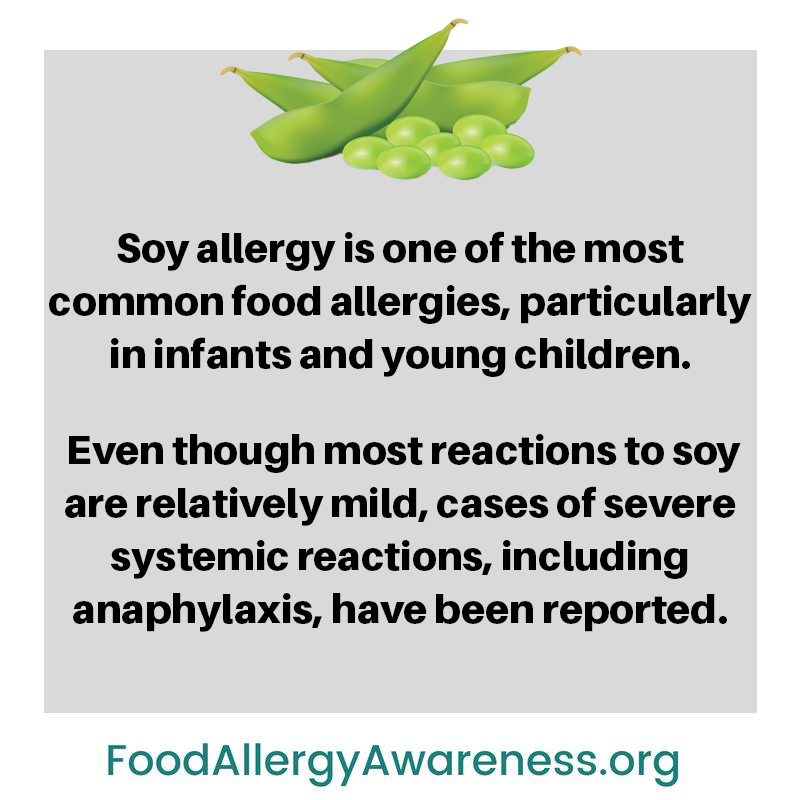
Soy
Soy allergy is one of the most common food allergies, particularly in infants and young children. Although it occurs in roughly 0.5% of children, soy allergy is typically outgrown by school age years and almost always by adolescence. Even though most reactions to soy are relatively mild, cases of severe systemic reactions, including anaphylaxis, have been reported. It is therefore imperative that individuals with soy allergy carefully read labels and carry epinephrine at all times. When considering food avoidance and reading labels, it is important to know that although soy is a member of the legume family, there is no increased risk of reactions to other legumes, such as beans, peas, lentils, and even peanuts. Soy-allergic individuals can also generally tolerate soybean oil and soy lecithin without difficulty, since these products carry little to no allergenic protein. Beyond the classical IgE-mediated allergic reactions that pose a risk of anaphylaxis, soy can also cause a variety of symptoms through additional mechanisms. Examples include soy intolerance, or triggers for conditions such as eosinophilic esophagitis and food protein-induced proctocolitis. A thorough evaluation with a board-certified allergist can help elucidate the specific type of reaction to soy and subsequent recommendations.
Practical Tips
It is recommended to always carry at least two (2) epinephrine auto-injectors at all times if you have been diagnosed with a food allergy, including soy allergy. This is in case one misfires or if symptoms recur and a second dose is needed. If an epinephrine auto-injector has been used, always seek emergency medical assistance immediately. This is due to the possibility of a biphasic reaction. A biphasic reaction is when a second wave of symptoms occurs. This typically happens from 2-6 hours following the initial reaction.
Read all product labels prior to the consumption of a new food product. Before consuming any products, it is important to always read labels carefully to ensure the safety of food products. All food products that contain soy protein as an ingredient are required by FALCPA law to list the word “Soy” on the product label. Please note, manufacturing practices may change without notice. According to the Food Allergen Labeling and Consumer Protection Act (FALCPA), food products with advisory statements such as “may contain,” “processed in the same plant,” or “manufactured on the same line” on a package are completely voluntary, and can be ambiguous. The true level of contamination is not declared, and may range from parts per million to micrograms. There may be different risks associated with these levels; it is generally recommended to avoid products with such labeling because of this uncertainty, but you should discuss with your allergist which particular labels should be avoided.
Visiting restaurants can be a pleasant experience for family and friends to gather together. However, some restaurants may pose as a risk. Asian restaurants are considered high risk for individuals with a soy allergy due to the common use of soy as an ingredient, as well as the associated risk of cross-contaminated cooking surfaces and utensils. Please review our restaurant page for tips on how to manage visiting a restaurant. Be vigilant, ask questions, and if there is any doubt, don’t eat the food item in question.
AVOID foods that contain soy ingredients, such as:
- Soybean
- Soy protein
- Soy sauce
- Soya
- Edamame
- Miso
- Natto
- Shoyu
- Tofu
- Tamari
- Tempeh
Foods that may contain soy as a hidden or unexpected ingredient:
- Asian cuisine
- Baked goods
- Canned meats, including canned tuna
- Processed meats
- High protein energy bars
- Infant formulas
Other pages that may be of interest:
Visit FAACT's CROSS-CONTACT page to review how to properly clean allergens from hands and surfaces.
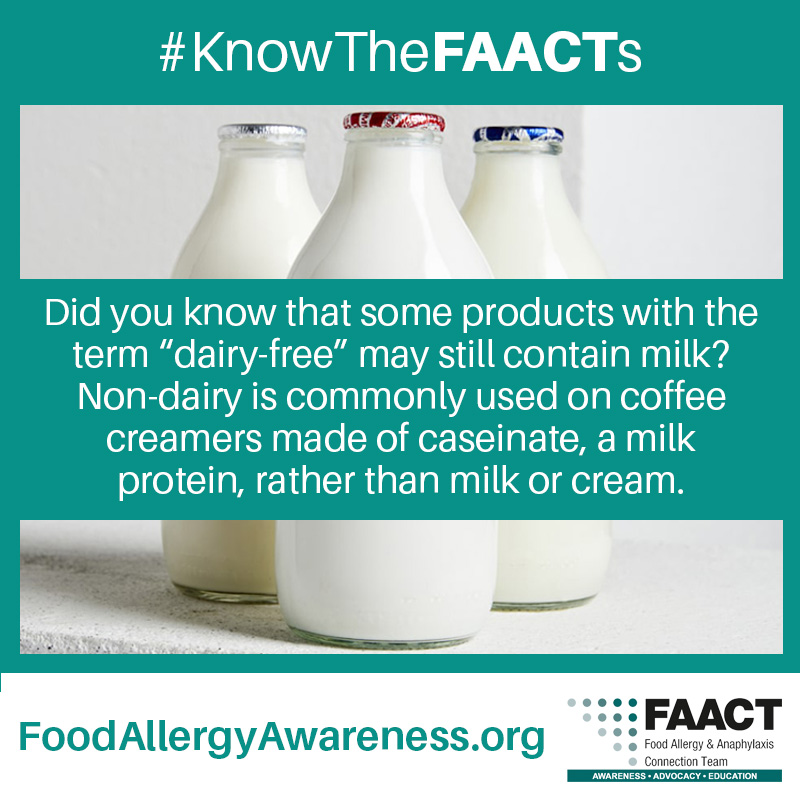
FAACT
Did you know that some products with the term “dairy-free” may still contain milk? The labeling of “dairy-free” have no regulatory definition by the FDA and therefore it is necessary to read ingredient labels to check for allergens. The term “non-dairy” has a regulatory definition. However, it DOES allow presence of milk protein, casein in products. Non-dairy is commonly used on coffee creamers made of caseinate, a milk protein, rather than milk or cream. If a milk allergic individual is unsure of a product, call the manufacturer to confirm safety prior to consumption.[1]
References
[1] FAARP http://farrp.unl.edu/resources/gi-fas/opinion-and-summaries/dairy-free-and-non-dairy
[2] Consortium of Food Allergy Research (CoFAR) https://web.emmes.com/study/cofar/MILK%20AVOIDANCE.pdf
[3] NLM/NIH MedlinePlus http://www.nlm.nih.gov/medlineplus/ency/article/002412.htm
[4] NLM/NIH MedlinePlus http://www.nlm.nih.gov/medlineplus/ency/article/002405.htm
[5] NLM/NIH MedlinePlus http://www.nlm.nih.gov/medlineplus/ency/article/002403.htm
[6] NLM/NIH MedlinePlus http://www.nlm.nih.gov/medlineplus/ency/article/002467.htm
NIH: https://www.ncbi.nlm.nih.gov/pubmed/23622009 (Warren CM1, Jhaveri S, Warrier MR, Smith B, Gupta RS)
FAACT
Did you know that peanuts are not actually a nut but a legume? Legumes are beans! Be aware that there is a very slight risk that individuals who are allergic to peanuts may also be allergic to other foods in the legume family. However, most peanut allergic individuals tolerate other legumes, and it is not generally recommended to avoid other legumes on account of a peanut allergy. We highly recommend that peanut allergic individuals seek the recommendation of a board-certified allergist for further guidance on this issue.
References
[1] Adapted from Groetch and Nowalk-Wegryzn, Pediatric Allergy and Immunology 2013 (24: 212–221).